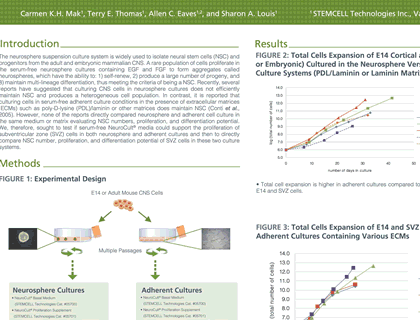
Optimized Reagents for the Reproducible Expansion and Differentiation of Adult and Embryonic Mouse Neural Stem Cells in Neurosphere and Adherent Cultures
Carmen K. H. Mak, Terry E. Thomas, Allen C. Eaves and Sharon A. Louis
Introduction:
The neurosphere suspension culture system is widely used to isolate neural stem cells (NSC) and progenitors from the adult and embryonic mammalian CNS. A rare population of cells proliferate in the serum-free neurosphere cultures containing EGF and FGF to form aggregates called neurospheres, which have the ability to: 1)self-renew, 2) produce a large number of progeny and 3) maintain multi-lineage differentiation, thus meeting the criteria of being and NSC. Recently, several reports have suggested that culturing CNS cells in neurosphere cultures does not efficiently maintain NSC and produces a heterogeneous cell population. In contrast, it is reported that culturing cells in serum-free adherent culture conditions in the presence of extracellular matrices (ECMs) such as poly-D-lysine (PDL)/laminin or other matrices does maintain NSC (Conti et al., 2005). However, none of the reports directly compared neurosphere and adherent cell culture in the same medium or matrix evaluating NSC numbers, proliferation and differentiation potential. We, therefore, sought to test if serum-free NeuroCult™ media couls support the proliferation of subventricular zone (SVZ) cells in both neurosphere and adherent cultures and then to directly compare NSC number, proliferation, and differentiation potential of SVZ cells in these two culture systems.